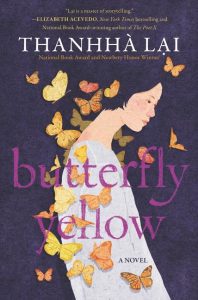
Butterfly Yellow
Written by Thanhhà Lại
HarperCollins, 2020, 284 pp
ISBN 978-0-06-222921-2
Winner of the 2019 Scott O’Dell Award for Historical Fiction, Butterfly Yellow has a unique approach to portraying the language strategies of the Vietnamese main character, Hằng, who arrives in the U.S. to search for her younger brother. Six year earlier, her brother was taken from her arms to a plane during the chaotic fall of Saigon, a misunderstanding for which she continues to carry heavy guilt. When she finds her now nine-year-old brother, he wants nothing to do with her, claiming to remember nothing of their family or Vietnam. Set in 1981 Texas, eighteen-year-old Hằng takes a job on a nearby ranch, determined to find a way into her brother’s memories and life. LeeRoy, an aspiring cowboy, becomes entangled in Hằng’s search for redemption and in the gradual revelation of the painful secret of what happened on her boat journey to escape Vietnam. Hằng and LeeRoy serve as narrators of alternating chapters, portraying their love/hate relationship amidst Hằng’s stubbornness and LeeRoy’s unrealistic dreams. The story lingers long in the reader’s memory, offering a deeply touching view of the continuing consequences of war.
Hằng uses Vietnamese syllables to pronounce English words in her conversations with others, a reflection of her strategy to make sense of this new confusing language through connections to her first language. Readers need to read aloud these syllables, sounding them out to make sense of what Hằng is saying. In addition, readers are supported by the strategy of having LeeRoy repeat much of what she says, checking his understandings of her dialogue. Lai says that she is a voice-driven author and storyteller and so strives to get inside the character’s mind, in this case the mind of a character who is an English language learner and thinks in Vietnamese.
Lai’s beautiful storytelling, full of warmth and powerful imagery, shines in this novel as does her ability to balance humor and trauma. Lai says that this book grew out of listening to stories from Vietnamese refugees as a reporter and deciding to write a book about healing rather than horror.
On her website, Lai talks about a memorial room in a Buddhist temple in San Diego that is full of photographs of those who have passed, including one section of black-and-white images, all of whom are young and who lost their lives in hopeful attempts to cross the sea as refugees. One image of a girl, staring with intensity, remained with her over many years. Lai researched what might have caused her to join the many Vietnamese who escaped after the war and imagined what she might have witnessed at sea. She decided to focus on what happens to Hằng upon landing in a safe place, instead of the horrifying journey across the sea. She set the book in the Texas panhandle to portray a stark contrast between the lush greenness of her own land with the dry flat Texas landscape. Lai spent her adolescence in Ft. Worth, so drew upon those memories and on interactions with classmates to develop the character of LeeRoy.
Given Lai’s positioning of herself as a voice-driver storyteller, pairing this novel with her middle-grade novels provides additional connections to language. Her award-winning novel-in-verse, Inside Out & Back Again, was inspired by her childhood experiences as a refugee fleeing from Vietnam to Alabama. In writing this book, she thought in Vietnamese, a tonal poetic language, and wrote in English, and so the verse format most effectively conveyed the voice she was hearing inside the character’s head. In addition, her mother was a house poet and so her voice was inside Lai’s mind as she wrote. This book also includes the character’s struggles in learning English (a language that hisses like a snake). Her second novel, Listen Slowly, is a realistic fiction book about a Laguna Beach girl who reluctantly returns to Vietnam with her grandmother to search for family. Language again plays a prominent role, both in writing the distinct voices of the grandmother and the girl, but also as characters translate for each other from Vietnamese to English and vice versa.
This book could be paired with books about language learners and communicating across languages, including picturebooks such as Drawn Together by Minh Le and Dan Santat (2018), My Two Blankets by Irene Kobald and Freya Blackwood (2014), Mango, Abuela and Me by Meg Medina and Angela Dominguez (2015), and I’m New Here by Anne Sibley O’Brien (2016). Novels that pick up on issues of immigration and language learning include Pie in the Sky by Remy Lai (2019) and Other Words for Home by Jasmine Warga (2019). When My Name Was Keoko (Linda Sue Park, 2012) and The Language Inside (Holly Thompson, 2013) would be excellent pairings to discuss how language is integral to culture. Finally, picturebooks about Vietnamese refugee experiences include The Paper Boat (Thao Lam, 2020), Adrift at Sea (Marsha Skrypuch and Tuan Ho, 2016), and The Lotus Seed (Sherry Garland and Tatsuro Kiuchi, 1993).
Thanhhà Lại is a Vietnamese-American author of middle grade and young adult novels, who came to the U.S. from Vietnam when she was a child. Her first novel, Inside Out & Back Again (2011), which won the National Book Award and a Newbery Honor, is based on her childhood as a refugee in the southern U.S. She is currently writing a sequel to this book. She has worked as a reporter and lives in upstate New York with her family. She established a nonprofit organization, Viet Kids, Inc., that purchases bikes for poor students who live several hours from school. More information about Lai can be found on her website and in the Author’s Corner by Susan Corapi.
Kathy G. Short, University of Arizona

